A rare 1976 $2 bill recently sold for an astonishing $35,250, sparking excitement among collectors and everyday folks wondering if their old cash could be a hidden treasure. These $2 bills, featuring Thomas Jefferson on the front and a painting of the Declaration of Independence on the back, were issued to celebrate America’s Bicentennial. While most are worth just $2, certain ones with unique features or errors have skyrocketed in value. Could one be sitting in your wallet or a drawer at home?
A Bill Born for a Big Celebration
The 1976 $2 bill was released as part of America’s 200th birthday celebration, marking the signing of the Declaration of Independence. First issued in large numbers in 1976, these bills were special because $2 notes were rare in modern times, making them a novelty. Millions were printed, and many were saved as keepsakes, but some stand out due to printing errors or unique serial numbers. These rare bills, often tucked away in wallets or old envelopes, are now catching collectors’ eyes for their surprising value.
Why Some $2 Bills Are Worth Thousands
What turns a $2 bill into a $35,250 jackpot? It’s all about rarity, condition, and special traits. Some 1976 $2 bills have unique serial numbers, like low digits (00000001) or “ladder” sequences (12345678), which collectors prize. Others have printing errors, like misaligned ink, double prints, or missing elements. Bills from certain Federal Reserve Banks, especially those with a star (*) in the serial number, are rarer and more valuable. While the $35,250 sale is real, such a high price likely comes from a pristine bill with a rare feature. Similar bills have sold for hundreds or thousands, but this one hit the jackpot due to its unique appeal.
How to Spot a Valuable $2 Bill
To check if your 1976 $2 bill is valuable, look for these details:
| Feature | Details to Look For |
|---|---|
| Serial Number | Low numbers (e.g., 00000001), ladder (12345678), or star (*) |
| Errors | Misaligned print, double print, or missing ink |
| Federal Reserve Bank | Check the bank name (e.g., San Francisco, Boston) |
| Condition | Crisp, uncirculated, no folds or tears |
| Date | 1976 (Bicentennial issue) |
If your bill has these traits, take it to a professional grader like PCGS Currency or PMG for appraisal.
Could These Bills Still Be Out There?
The thrill of finding a $35,250 bill keeps collectors and dreamers searching. Millions of 1976 $2 bills were printed, and many are still in circulation, stashed in wallets, cash registers, or old collections. Some were saved as souvenirs, increasing the odds they’re in great condition. Stories of valuable bills found in thrift stores or family keepsakes fuel the hunt. While a $35,250 price is rare, experts say bills with special serial numbers or errors could still turn up, making it worth checking any $2 bills you come across.
What to Do If You Find One
If you think you’ve got a rare 1976 $2 bill, handle it carefully don’t fold or mark it, as damage can lower its value. Store it in a protective sleeve and take it to a trusted currency dealer or grading service for authentication. If it’s genuine and in top shape, selling it at auction could bring a big payout. Even if it’s not worth $35,250, many rare $2 bills sell for hundreds or thousands. So, next time you spot a $2 bill in your wallet or a drawer, take a closer look you might just be holding a small fortune!


